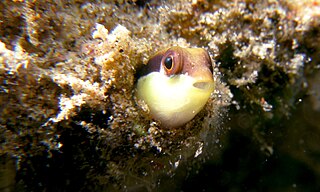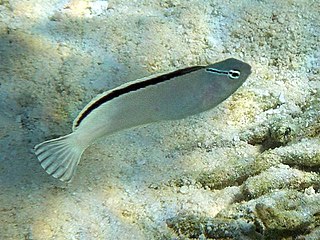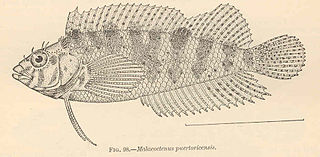The resplendent pygmy angelfish is a species of marine ray-finned fish, a marine angelfish, belonging to the family Pomacanthidae. It is endemic to Ascension Island in the South Atlantic Ocean.

Lamprologus lemairii is a species of cichlid endemic to Lake Tanganyika where it prefers to lurk by rocks or on the lake bed waiting for fish to prey on. This species can reach a length of 25 centimetres (9.8 in) TL. The specific name of this fish honours the leader of the Congo Free State expedition which collected the type, Lieutenant Charles Lemaire (1863-1925).

The pindani is a species of cichlid endemic to Lake Malawi preferring areas with sandy substrates and nearby rocks where the males establish their territories. This species can reach a length of 6.7 centimetres (2.6 in) SL. It can also be found in the aquarium trade. The specific name of this fish honours the aquarium fish trader Ross Socolof (1925-2009).

Pseudochromis sankeyi, the striped dottyback, is a species of ray-finned fish from the Western Indian Ocean which is a member of the family Pseudochromidae. It occasionally makes its way into the aquarium trade. It grows to a size of 7 cm in length. The specific name honours the British collector and wholesaler of marine fish Richard D. Sankey, who gave Roger Lubbock study specimens.

Meiacanthus smithi, the disco blenny, is a species of combtooth blenny found in coral reefs in the eastern Indian ocean. This species grows to a length of 8.5 centimetres (3.3 in) TL. It is also commonly known as Smith's fangblenny, Smith's sawtail blenny or Smith's harp-tail blenny. This species is also found in the aquarium trade. The specific name honours the South African chemist and ichthyologist James Leonard Brierley Smith (1897–1968) of Rhodes University in Grahamstown.
Omobranchus smithi is a species of combtooth blenny found in the western Pacific and Indian ocean.
Scartella springeri is a species of combtooth blenny found in the eastern Atlantic Ocean, around St. Helena. This species reaches a length of 8.2 centimetres (3.2 in) SL. The specific name honours the American ichthyologist Victor G. Springer of the U.S. National Museum.

Ecsenius alleni, known commonly as the Allen's blenny, is a species of combtooth blenny in the genus Ecsenius. It is found in coral reefs in the eastern Indian ocean, specifically in western Australia. It can reach a maximum length of 3.4 centimetres. The blennies feed primarily off of plants and algae. The specific name honours the ichthyologist Gerald R. Allen.
Ecsenius lubbocki, known commonly as the Lubbock's combtooth-blenny in Indonesia, is a species of combtooth blenny in the genus Ecsenius. It is found in coral reefs in Phuket, Thailand, in the eastern Indian ocean. It can reach a maximum length of 4 centimetres. Blennies in this species feed primarily off of plants, including benthic algae and weeds. The specific name honours the English marine biologist Hugh Roger Lubbock (1951-1981), the collector of the type specimens, he recognised that they were a new species of Ecsenius.
Platygillellus smithi is a species of sand stargazer native to the waters around the Bahamas where it occurs at depths of from 0 to 9 metres. It can reach a maximum length of 3.4 centimetres (1.3 in) SL. Its specific name honours the collector of the type C. Lavett Smith (1927-2015) who was curator of fishes at the American Museum of Natural History.

Malacoctenus gilli, the dusky blenny, is a species of labrisomid blenny native to the Atlantic Ocean including the Gulf of Mexico and the Caribbean Sea from the Bahamas to the north coast of South America. This species inhabits reef patches, areas of sandy substrates with available rocks and beds of seagrass at depths of from 1 to 5 metres. It can reach a length of 7.6 centimetres (3.0 in) TL. The person honoured in the patronym of this species was not identified by Steindachner but it is most probably the American ichthyologist Theodore Nicholas Gill (1837-1914), the authority for the generic name Malacoctenus.

Starksia sluiteri, the chessboard blenny, is a species of labrisomid blenny native to the Caribbean Sea and the Atlantic Ocean along the coast of Brazil including Atol das Rocas and St. Paul's Rocks. This species is an inhabitant of reefs where it prefers areas with rubble or crevices in which to hide. It can be found at depths of from 5 to 40 m. This species can reach a length of 2.8 cm (1.1 in) SL. The specific name honours the Dutch biologist and anatomist Carel Philip Sluiter (1854-1933), a specialist in tunicates.
Enneanectes boehlkei, known commonly as the roughhead triplefin, is a species of triplefin blenny. This species occurs in the western Atlantic Ocean from the Bahamas west into the Gulf of Mexico, including the Florida Keys to Tuxpan, Mexico and throughout the Caribbean, it is absent from most of Cuba except the north west, and off the northern South American coast its range extends from Cartagena, Colombia to the Orinoco River in Venezuela. The specific name honours the American ichthyologist James Erwin Böhlke (1930-1982) of the Academy of Natural Sciences of Philadelphia.

Enneanectes jordani, known commonly as the redbelly triplefin and the mimic triplefin, is a species of triplefin blenny from the northern Caribbean Sea and the Gulf of Mexico south as far as Venezuela. The specific name honours the American ichthyologist David Starr Jordan (1851-1931). Some authorities consider the synonym Enneanectes pectoralis to be a valid species.

Pomatoschistus knerii, Kner's goby, is a species of goby native to the western basin of the Mediterranean Sea and the Adriatic Sea. This species occurs in areas with soft substrates near to rocks or beds of seagrass. The specific name most likely honours the Austrian ichthyologist Rudolf Kner (1810-1869), who was a friend of the author Franz Steindachner.
Enneapterygius shaoi is a species of triplefin blenny in the genus Enneapterygius. It was described by Chiang Min-Chia and Chen I-Shiung in 2008. The specific name honours the ichthyologist and marine ecologist Kwang-Tsao Shao of the Biodiversity Research Center at the Academia Sinica in Taiwan. It occurs off the eastern and southern coast of Taiwan.
Enneapterygius sheni is a species of triplefin blenny in the genus Enneapterygius. It was described by Chiang Min-Chia and Chen I-Shiung in 2008. The specific name honours the ichthyologist Shieh-Chieh Shen of the National Taiwan University. This species has only been recorded from the southern tip of Taiwan.
Chromis lubbocki is a species of marine fish of the family Pomacentridae. This fish grows to 12.5 cm maximal length. It occurs in the eastern Atlantic Ocean, off the coast of Cape Verde. The specific name honours the marine biologist Hugh Roger Lubbock (1951-1981) who led the Cambridge Expedition to Saint Paul's Rocks, part of the Cape Verde Islands, who collected the type specimen and realised it was a new species.
Lubbockichthys is a genus of ray-finned fish from the Indo-Pacific region which belongs to the subfamily Pseudoplesiopinae, part of the family Pseudochromidae, the dottybacks. The species in this genus have small cycloid scales throughout their lives; some of their head bones have a weakly honeycombed surface; and the parietal bone encloses the rear section of the supratemporal laterosensory canal.
Smith's butterflyfish is a species of marine ray-finned fish, a butterflyfish belonging to the family Chaetodontidae. This species is endemic to the south western Pacific Ocean.









